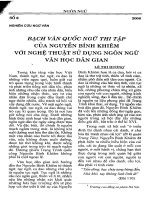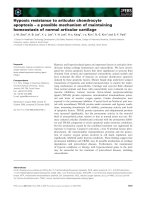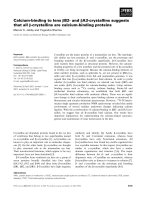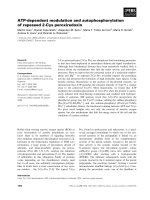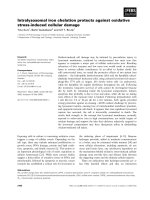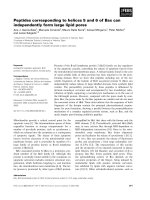Tài liệu Báo cáo khoa học: Computational approaches to understand a-conotoxin interactions at neuronal nicotinic receptors doc
Bạn đang xem bản rút gọn của tài liệu. Xem và tải ngay bản đầy đủ của tài liệu tại đây (491.11 KB, 8 trang )
MINIREVIEW
Computational approaches to understand a-conotoxin interactions
at neuronal nicotinic receptors
Se
´
bastien Dutertre and Richard J. Lewis
Institute for Molecular Bioscience, University of Queensland, Brisbane, Queensland, Australia
Recent and increasing use of computational tools in the field
of nicotinic receptors has led to the publication of several
models of ligand–receptor interactions. These models are all
based on the crystal structure at 2.7 A
˚
resolution of a protein
related to the extracellular N-terminus of nicotinic acetyl-
choline receptors (nAChRs), the acetylcholine binding pro-
tein. In the absence of any X-ray or NMR information on
nAChRs, this new structure has provided a reliable alter-
native to study the nAChR structure. We are now able to
build homology models of the binding domain of any
nAChR subtype and fit in different ligands using docking
programs. This strategy has already been performed suc-
cessfully for the docking of several nAChR agonists and
antagonists. This minireview focuses on the interaction of
a-conotoxins with neuronal nicotinic receptors in light of our
new understanding of the receptor structure. Computational
tools are expected to reveal the molecular recognition
mechanisms that govern the interaction between a-cono-
toxins and neuronal nAChRs at the molecular level. An
accurate determination of their binding modes on the
neuronal nAChR may allow the rational design of a-cono-
toxin-based ligands with novel nAChR selectivity.
Keywords: a-conotoxins; computational tools; docking
simulation; homology modeling; neuronal nicotinic acetyl-
choline receptor.
Introduction
Neuronally active a-conotoxins are disulfide rich mini-
proteins produced in the venom of predatory Conus species.
They were first discovered in 1994 and represent valuable
pharmacological tools for the study of electrophysiological
properties of nicotinic acetylcholine receptor (nAChR)
subtypes and their distribution in native tissues [1].
Although a lot is known about these a-conotoxins (see
other reviews in this series; [1a)c]), including their three-
dimensional structure, functional determinants and pairwise
interactions with their specific target, the lack of informa-
tion on the nAChR three-dimensional structure has
prevented attempts to gain molecular insights into the
toxin–receptor interaction (Table 1).
In 2001, this situation changed dramatically when Sixma
and colleagues published the high-resolution crystal struc-
ture of an acetylcholine binding protein (AChBP), a soluble
protein homologue to the extracellular domain of nAChRs
[2]. This structure revealed the acetylcholine (ACh) binding
site in great detail and rationalized the interpretation of more
than 30 years of research on nAChRs. This new molecule
also served as a template for building models of nAChRs,
which were subsequently used for docking studies of several
nAChR ligands. Indeed, combining experimental data with
today’s high-performance computational tools, we can now
predict and simulate the ligand–receptor interaction.
The accurate identification of a-conotoxin interactions
with the neuronal nAChR using homology modeling and
docking simulations is expected to provide new information
into how these small peptides achieve their remarkable
selectivity. Several NMR and X-ray structures of a-cono-
toxins are available, and for some of them, identified pairwise
interactions can guide the docking process and lead to an
accurate solution. Their docking modes on nAChR homol-
ogy models will also help to distinguish between distinct
toxin binding sites and identify how they acheive their unique
selectivity. From experimental data, four microsites have
already emerged for the nAChRs: one common a-neuro-
toxin microsite and several distinct a-conotoxin microsites.
Such distinctions in nAChR binding modes are particularly
important as they could represent the specific targets
required to produce highly subtype selective drugs with
fewer side-effects [3]. a-Conotoxins that bind to nAChRs
with very high affinity and selectivity could be used as natural
scaffolds in the design of new therapeutic agents based on
the structure of neuronal nAChR homology models.
Structure of nAChRs
Pre-AChBP view of nAChR structure
In the past half-century, nAChRs, which are the proto-
typical receptors of the ligand-gated ion channel super-
family, have led to an impressive number of physiological,
Correspondence to R. J. Lewis, Institute for Molecular Bioscience,
University of Queensland, Brisbane, Queensland 4072, Australia.
Fax: + 61 73346 2101, Tel.: + 61 73346 2984,
E-mail:
Abbreviations: ACh, acetylcholine; AChBP, acetylcholine binding
protein; nAChR, nicotinic acetylcholine receptor; SAR, structure-
activity relationship.
(Received 22 January 2004, revised 17 March 2004,
accepted 6 April 2004)
Eur. J. Biochem. 271, 2327–2334 (2004) Ó FEBS 2004 doi:10.1111/j.1432-1033.2004.04147.x
pharmacological and structural studies (reviewed in [4,5]).
Most of the work has been performed on the muscle
subtype, thanks to the large amount of the receptor
obtained from the electric organ of the Torpedo marmorata
ray and availability of selective pharmacological tools like
the snake a-neurotoxins. The analysis of both muscle and
neuronal subunit sequences reveal a high degree of identity
and similar hydropathy plots, and therefore, we can
extrapolate the majority of these structural data to the
neuronal subtypes [5].
The overall structure of the neuronal nAChR is a
homo- (only a7, a8ora9) or hetero-pentamer composed
from the 12 subunits (a2–a10; b2–b4) that have been
identified in mammalian species so far [6]. Each subunit
possesses an extracellular N-terminus (ligand binding
domain), four transmembrane domains, an intracellular
loop and an extracellular C-terminus. a4/b2 Receptors,
which mainly control pain [7], and a7 receptors are the
most abundant nAChR subtypes in the mammalian brain
[3]. Studies also indicate significant expression levels of a3,
a5andb4 subunits in different nuclei of the brain [8]. As a
result of their role in the propagation of action potentials,
cognitive function and involvement in diverse central
nervous system pathologies including pain, they are targets
for many drugs and toxins. In addition to the ACh
binding site, many other binding sites on nAChRs have
been identified. There is a binding site for positive
allosteric modulators (increased neuronal nAChR-medi-
ated ion conductance), two binding sites for noncompet-
itive blockers or negative allosteric modulators, and a
steroid binding site [8].
Fluorescence measurements using labelled a-neurotoxin
first revealed the localization of the competitive binding site
close to the outer perimeter of the muscle nAChR at a
distance of 39–45 A
˚
from the membrane surface [9]. This
was later confirmed by the electron microscopy of the
Torpedo receptor at 4.6 A
˚
resolution, showing the location
of the putative ACh binding site cavities 30 A
˚
away from
the membrane [10]. Intensive mutagenesis studies have
shown that competitive agonists and antagonists bind at the
interface between a–a or a–b subunits, identifying a vicinal
disulfide and several conserved aromatic residues located on
six segments (or loops) A–F [4]. Segments A, B and C are
part of the principal component (subunits a
1
for muscle and
a(+) for the neuronal subtypes), while segments D, E and F
are part of the complementary component (c, d or e for
muscle and a(–) or b for the neuronal subtypes) [11].
Acetylcholine binding protein
Although a large amount of structural information has
become available on the nAChR topology during the last
decade [4], its three-dimensional structure still remains
unknown. Surprisingly, the first molecular insights con-
cerning nAChRs structure came from the crystal structure
at atomic resolution of an acetylcholine binding protein
(AChBP) extracted from the Mollusca Lymnaea stagnalis
[2]. AChBP is a soluble, glia-derived protein that modu-
lates synaptic transmission in the mollusc’s brain, binds
ACh and other nAChR ligands, and resembles the
N-terminus ligand binding domain of nAChRs. The
structure shows five identical subunits arranged in a
cylinder of 80 A
˚
in diameter with a central pore of 18 A
˚
(Fig. 1), in agreement with the dimensions expected for
the ligand binding domain of nAChRs from Torpedo
electron microscopy data [10]. The rich b strand compo-
sition of AChBP is also in accordance with secondary
structure prediction for the N-terminus of nAChR subunit
[12]. Each AChBP subunit possesses an a helix, two short
3
10
helices and 10 stranded b sheets, revealing an
immunoglobulin-like subunit topology (Fig. 2). The bind-
ing site is found in a cleft comprised mainly of aromatic
residues from loops A–F and a series of b strands at the
interface of two subunits, in accordance with the mutation
experiments on nAChRs.
Homology models of the neuronal nAChR
ligand binding domain
The template: a high resolution structure of AChBP
AChBP is not an ion channel (it is a soluble protein that
lacks the transmembrane/intracellular parts compared to
nAChRs), but importantly displays many nAChR prop-
erties, including binding of nAChR ligands [13] and a
conformational change in response to agonist binding [14].
Interestingly, the highest percentage of identity (26.5%)
has been found with the ligand binding domain of the a7
neuronal nAChR subtype (Fig. 1). This percentage increa-
ses dramatically when considering only the loops forming
the ACh binding pocket (40–60%), as expected given
the functional homology [15]. The sequence alignment
between the rat nAChR subunit and AChBP sequences
revealed a very good fit with only few gaps of one or two
residues (Fig. 3). A misaligned domain resulting in a gap
Table 1. a-Conotoxins active on neuronal nAChR subtypes. *, C-terminal amidation; O, hydroxyproline; Ys, sulfated tyrosine; c, c-carboxyglutamic
acid. Conserved residues shaded.
2328 S. Dutertre and R. J. Lewis (Eur. J. Biochem. 271) Ó FEBS 2004
of four residues occurs in loop C for the b subunits,
which lack the vicinal disulfide found in AChBP and the
a subunits. This effect on structure is not an issue for the
analysis of the ACh binding site (and the docking
simulation of ligands) because loop C of the b subunit
is not involved in the competitive binding site [16]. Finally,
the important residues for the binding of ACh and other
competitive ligands are conserved in the AChBP sequence,
explaining why AChBP also binds nicotine, epibatine,
(+)-tubocurarine and a-bungarotoxin [5]. Therefore,
AChBP is considered a reliable structure for nAChR
homology modeling and docking simulations of compet-
itive ligands [17].
Modeling methods
The recent and growing literature dealing with nAChR
homology models based on the AChBP structure reveals
that two main modeling approaches can be used that each
produce similar high quality models. The first one will be
referenced as the Ômanual methodÕ. The process of building
a model for a protein using this method is divided into
different steps. The first and critical step in all molecular
modeling is to get the alignment between template and
target sequences optimised. Some programs exist that do
this automatically. However, despite their improvements,
the results in some cases still need to be manually refined to
further increase the percentage of identity and eliminate
aberrations. The following steps are: (a) determine the
structurally conserved regions and assign directly the
coordinates of these regions from the template to the target
sequence; (b) generate random loops for the insertions/
deletions (or use a structural database search); (c) assign the
coordinates of the chosen loop to the model, and finally (d)
refine/relax the new structure using minimization/dynamic
simulations. The second approach will be called the
Ôautomated methodÕ in contrast to the first one. It generates
a whole structure from the target sequence based on the
alignment with the experimentally solved homologue struc-
ture. Besides the commercially available software,
SWISS
-
MODEL
is a server devoted to this task and is available free
of charge at the ExPASY site ( />swissmod/).
These methods or derivatives of these have led to the
publication of a number of modelled nAChR structures,
including: muscle nAChR subtype of human [18], human
D
-tubocurarine–metocurine complex [19], mouse [20],
mouse
D
-tubocurarine complex [21], torpedo ray [22,23],
torpedo a-bungarotoxin complex [24], nAChR DEG-3
mutant [25], a7 nAChR neuronal subtype of human [26],
chick [23], chick a-cobratoxin complex [15], a4b2 nAChR
neuronal subtype of human [26], rat [23], and a3b2 and
a4b4 nAChR neuronal subtype of human [26].
Fig. 2. AChBP subunit structure.
Fig. 1. AChBP three-dimensional structure (PDB:1I9B). (A) Side view.
(B) Top view. (+)W143, (+)Y89, (+)Y185, (–)W53, (–)Y164 and
(+)Y192 are in ball and stick representation. Figures were prepared
using the program
PYMOL
( />Ó FEBS 2004 Modeling a-conotoxin–nAChR interactions (Eur. J. Biochem. 271) 2329
Exploration at the molecular level of models
of the neuronal nAChRs
As neuronal nAChRs are attractive targets for treating many
diseases such as cognitive dysfunction, neurodegeneration
and other central nervous system pathologies [3,8],
exciting developments in drug discovery/drug design
focusing on new selective nAChR compounds are now
emerging since the AChBP structure was first described.
Agonist or antagonist drugs that selectively target receptor
subtypes could be designed that maximize the desired
effect and minimize the side-effects. While subtype select-
ive antagonists, a-conotoxins, may prove to be beneficial
in the treatment of certain neuropathology and diseases
[27], it is far more challenging to convert them to agonist
acting drugs for a wider therapeutic application, whilst
maintaining their other remarkable features. We have
generated homology models of several nAChR subtypes
[27a], so that we can start to analyse in detail the nAChR
pharmacophore that binds a-conotoxins at the molecular
level. As expected, the nAChR binding pocket contains
the same hydrophobic cage as the AChBP structure,
formed by six aromatic residues. However, several non-
conserved residues lining this conserved pocket are more
interesting, as they are likely to be responsible for the
observed subtype selectivity of a-conotoxins and other
ligands (Fig. 4).
Care is needed when analysing models built upon a
crystal structure. During the crystallization process, the
packing forces fix the molecule (in particular the flexible
loops) in a certain conformation, which does not necessarily
reflect the true or ideal state for ligand recognition. In
addition, the sequence threading of a homology modeling
procedure can introduce additional errors, as the loop
lengths and the side chains are different. In AChBP, the
b9/b10 hairpin covers the binding site, but one can easily
imagine it as a flexible loop that could allow a more open
binding site in the physiological resting state than that
shown in the crystal. However, the most likely access routes
to the ligand binding site are from above or below the
double cysteine-containing loop C. Indeed, we can identify
two cavities at the interface between adjacent subunits from
visual inspection of the molecular surface of AChBP and
nAChR homology models (Fig. 4). For instance, on an a7
nAChR model, a large cavity appears below the b9/b10
hairpin and is made of loop C (+), the C-terminus of loop F
(–), loop A (+) and the C-terminus of the b6 (–) strand
while a narrower one exists above, with contributions from
loop C (+), loop B (+), loop E (–), the N-terminus of the
b6(–)andb1 (–) strands and the C-terminus of the b2 (–)
strand. In addition to these observations, several lines of
experimental evidence reinforce these cavities as the obvious
access routes for the binding of competitive ligands. First,
a-neurotoxin docking based on double-mutant cycle ana-
lysis and NMR data show that they achieve their antagonist
activity by targeting the larger cavity. Indeed, they insert the
tip of their loop II into the ACh binding pocket from below
the b9/b10 hairpin to occupy the binding pocket [15,28].
Secondly, residues that confer selectivity for smaller antag-
onists like the Waglerin have been mapped in the small
Fig. 3. Sequence alignment between AChBP and the N-terminal binding domain of rat nAChR subunits. Secondary structures of AChBP (a, a helices;
b, b sheet) and previously identified nAChR loops are indicated above the alignment. Dark grey, residues common to AChBP and the nAChR
sequences; light grey, residues common only to the nAChR subunits; squares, residues involved in the a-conotoxin binding site.
2330 S. Dutertre and R. J. Lewis (Eur. J. Biochem. 271) Ó FEBS 2004
cavity above the b9/b10 hairpin [20]. Finally, recent docking
of metocurine and
D
-tubocurarine on AChBP structure
revealed that they both bind the ACh pocket by extending
into the small cavity [29]. In a hypothesis involving a single
pharmacophore, competitive antagonists would interact
with the same binding site, but via different binding modes.
Here, it is strongly suggested that more than one binding site
exists for competitive ligands on nAChRs, and probably
more than one binding mode for each binding site. From
these initial results, it seems probable that smaller ligands
might bind preferentially in the small cavity, while large
ligands, like three-finger snake toxins, would only bind in
the larger cavity. This raises the question Ôhow do the
a-conotoxins bind to the different nAChR subtypes?Õ,as
they are of intermediate size.
a-Conotoxin docking modes on neuronal
nAChRs
a-Conotoxin binding sites
Of the 11 neuronally active a-conotoxins, four have been the
subject of more intense investigations: ImI, PnIB, PnIA and
MII (Fig. 5). Their structure-activity relationship (SAR)
with nAChRs has already been reviewed elsewhere [1,30].
However, the nAChR homology models provide for the
first time a three-dimensional visualization of their binding
determinants on a7anda3b2. In Fig. 4, these determinants
have been mapped and a-conotoxins appear to bind mainly
to loop C, but also clearly extend to microsites above this
loop and on the b9b10 hairpin. Indeed, a-conotoxins act at
the competitive nAChRs binding site, which, in light of the
AChBP structure, is mainly defined by a 10 A
˚
hydrophobic
Fig. 5. a-Conotoxin structures. The right panel is rotated 90° around
the y-axis from the left panel. The figures were prepared using
SWISS
-
PDBVIEWER
[50].
Fig. 4. a7 and a3b2 nAChR homology models showing determinants
influencing a-conotoxin binding identified by mutagenesis. AChR side-
chainsaffecting.ImI,darkblue;PnIB,green;PnIA,pinkandMII,
turquoise are indicated. ImI and PnIB share W147 and Y193, while
PnIA and MII share I186. The small and large shaded regions repre-
sent the location of the small and large cavities, respectively.
Ó FEBS 2004 Modeling a-conotoxin–nAChR interactions (Eur. J. Biochem. 271) 2331
pocket. However, as conotoxins represent a larger volume,
they must use different subdomains outside the ACh
binding site to accommodate their bulky side chains [31].
a-Conotoxin subtype selectivity could therefore arise from
the amino acid composition and geometric conformation
of these microsites. The microsite hypothesis is supported
by different a-conotoxin sequences (Table 1), different
a-conotoxin kinetics [32–35], and finally, the involvement
of different nAChR residues from different regions of
nAChR subunit sequences (Table 2, Figs 4 and 5).
ImI, which has provided the most complete SAR with
regards to the a7 nAChR subtype, where it delineates a
discrete binding site above loop C. From the pairwise
interactions identified, the toxin must enter into the ACh
pocket with its N-terminus, placing the triad D5-P6-R7 in
van der Waals contact with (+)Y193 and (+)W147,
while the C-terminus makes contacts with the (–) face of
a7 nAChR, bridging the two subunits. All distances
measured from the model of a7 are compatible with ImIÕs
size and the distance constraints derived from mutagenesis
studies, indicating that the docking simulations probably
provide an accurate view of the molecular basis of the
interaction. PnIB determinants are located lower in the
ACh binding site, which is in accordance with different
binding sites for ImI and PnIB [31]. The mutagenesis
experiments suggest a highly hydrophobic interaction
between W147, Y91, Y186 and Y193 in the binding
pocket and the hydrophobic patch of PnIB L5, P6, P7,
A9 and L10. This deeper interaction would also explain
the slower dissociation kinetics of PnIB compared to ImI
[34,35]. Three residues on the a3 subunit have recently
been identified as specific determinants for PnIA [36]. It is
noteworthy that they are all on the b9/10 hairpin
containing loop C, which has an obvious structural role
for the ACh binding site shape and conformation changes
in the receptor [2]. I186, which is shared with MII as a
determinant on a3, is situated in the binding pocket, while
the two others appear further away. Indeed, a distance of
19 A
˚
has been measured between I186 and P180, making
a direct interaction of the toxin with both residues at the
same time unlikely. Moreover, the loss or gain of proline,
an amino acid known for its structural role, at position
180 and 196, respectively, may alter the C-loop confor-
mation and thereby affect the binding of PnIA indirectly
[36]. Similarly, three determinants of MII sensitivity have
been reported [37], but once again, a distance of 25 A
˚
has
been measured between two of them. With the exception
of K183, which is on the b9b10 hairpin, I186 and T57 are
in, or close to, the ACh binding site. In this view, the MII
binding site resembles the PnIB binding site.
The binding sites of ImII and ImI exhibit little if any
overlap and ImII shows a noticeably slower off-rate despite
having nine out of 12 amino acids in common with ImI [35].
Even if ImII appears to be an enigma in terms of its binding
site, we can exclude its location in the large cavity as it does
not inhibit a-bungarotoxin. Therefore, it probably binds the
ACh pocket from a new distinct microsite but still from
above the b9b10 hairpin. The binding sites of AuIB, AuIA,
AuIC, EpI, GIC and GID remain uncertain, as no SAR has
yet been published. Docking studies of these peptides would
allow the development of hypotheses that could be tested
experimentally.
Docking strategy
Toxins bind with higher affinity than endogenous ligands,
hence their toxicity. This important biological function
depends on a very accurate molecular recognition, mostly
based on complementary surface shape and electrostatic/
hydrophobic interactions. Therefore, an accurate predic-
tion of their binding mode can also provide insight into
designing possible leads for drug design. Docking pro-
grams can be invaluable tools in the rational drug design
as they are now able to predict the ligand–protein
interaction. Indeed, tests against protein–ligand complexes
from the PDB databank showed up to 80% of correct
docking for a particular program [38].
Briefly, protein–ligand interactions are mainly governed
by both shape complementary properties and energetic
contributions. The search algorithm explores the space to
generate different low energy conformations of the ligand
molecule. When information on the binding site is known,
as for protein with a well-defined pocket, it is possible to
limit the search to only part of the receptor and then reduce
the computing time. The resulting structures are ranked
using a scoring technique.
a-Conotoxin docking modes based on homology models
of nAChRs will most likely appear soon [39]. The compu-
Table 2. a-Conotoxin–nAChR binding interactions. ND, not deter-
mined.
Residues influencing affinity
Pairwise
interactions References
a7
(+) ()) ImI ImI/a7
W147 W53 D5 R7/Y193 [40–47]
Y193 S57 P6 D5/W147
T75
a
R7 W10/N109
N109 W10 W10/T75
Q115
a7
(+) ()) PnIB PnIB/a7
W147 S34 S4 L10/W147 [48,49]
Y91 P6 P6/W147
R184 P7 P7/Y91
Y186 A9
Y193 L10
a3b2
a3 b2 PnIA PnIA/a3b2
P180 ND A10 ND [31,36]
I186 N11
Q196
a3b2
a3 b2 MII MII/a3b2
K183 T57 ND ND [37]
I186
a
T75 (human) residue is replaced by N75 in the rat sequence.
2332 S. Dutertre and R. J. Lewis (Eur. J. Biochem. 271) Ó FEBS 2004
tational docking of ImI and PnIB, and to a certain extent
PnIA and MII, using homology models of neuronal
nAChRs would probably produce a reasonable solution
as pairwise interactions and determinants can efficiently
guide the scoring function. However, docking of other
a-conotoxins in the absence of restraints could lead to a
number of docking solutions being found within the ACh
pocket. Mutagenesis experiments designed from these
models could help to discriminate in favour of one
conformation. These docking simulations may subsequently
be used to guide virtual screening for new a-conotoxin
analogues with tailored selectivity.
Conclusions
Ironically, it seems that key components in understanding
mammalian nicotinic synaptic transmission have come from
molecules found in other subphyla. In addition to the
Torpedo mamorata’s synapses (pisces) and the snake’s
a-neurotoxins (reptilia), two molecules extracted from snails
(molluscs) have helped to probe the nAChRs structure/
function. The first one (Conus sp.) has provided powerful
pharmacological tools, the a-conotoxins; the second one
(Lymnaea sp.), thanks to the acetylcholine binding protein,
has revealed the structure of the binding domain of
nAChRs. Combining this information with the powerful
computational tools available today is facilitating drug
design at the nAChRs.
Acknowledgements
We thank Joel Tyndall, Christina Schroeder and Ivana Saska for their
comments on the manuscript. This work was supported by a grant from
the Australian Research Council.
References
1. McIntosh, J.M., Santos, A.D. & Olivera, B.M. (1999) Conus
peptides targeted to specific nicotinic acetylcholine receptor sub-
types. Annu. Rev. Biochem. 68, 59–88.
1a. Loughnan, M.L. & Alewood, P.F. (2004) Physico-chemical
characterization and synthesis of neuronally active a-conotoxins.
Eur. J. Biochem. 271, 2294–2304.
1b. Nicke, A., Wonnacott, S. & Lewis, R.J. (2004) a-Conotoxins as
tools for the elucidation of structure and function of neuronal
nicotinic acetylcholine receptor subtypes. Eur. J. Biochem. 271,
2305–2319.
1c. Millard, E.L., Daly, N.L. & Craik, D.J. (2004) Structure-activity
relationships of a-conotoxins targeting neuronal nicotinic acetyl-
choline receptors. Eur. J. Biochem. 271, 2320–2326.
2. Brejc, K., van Dijk, W.J., Klaassen, R.V., Schuurmans, M., van
DerOost,J.,Smit,A.B.&Sixma,T.K.(2001)Crystalstructureof
an ACh-binding protein reveals the ligand-binding domain of
nicotinic receptors. Nature 411, 269–276.
3. Dwoskin, L.P. & Crooks, P.A. (2001) Competitive neuronal
nicotinic receptor antagonists: a new direction for drug discovery.
J. Pharmacol. Exp. Ther. 298, 395–402.
4. Corringer, P.J., Le Novere, N. & Changeux, J.P. (2000) Nicotinic
receptors at the amino acid level. Annu. Rev. Pharmacol. Toxicol.
40, 431–458.
5. Karlin, A. (2002) Emerging structure of the nicotinic acetylcholine
receptors. Nat. Rev. Neurosci. 3, 102–114.
6. Sgard, F., Charpantier, E., Bertrand, S., Walker, N., Caput, D.,
Graham, D., Bertrand, D. & Besnard, F. (2002) A novel human
nicotinic receptor subunit, a10, that confers functionality to the
a9-subunit. Mol. Pharmacol. 61, 150–159.
7. Marubio, L.M., del Mar. Arroyo-Jimenez, M., Cordero-Eraus-
quin,M.,Lena,C.,LeNovere,N.,deKerchoved’Exaerde,A.,
Huchet, M., Damaj, M.I. & Changeux, J.P. (1999) Reduced
antinociception in mice lacking neuronal nicotinic receptor
subunits. Nature 398, 805–810.
8. Lloyd, G.K. & Williams, M. (2000) Neuronal nicotinic acetyl-
choline receptors as novel drug targets. J. Pharmacol. Exp. Ther.
292, 461–467.
9. Johnson, D.A., Cushman, R. & Malekzadeh, R. (1990) Orienta-
tion of cobra a-toxin on the nicotinic acetylcholine receptor.
Fluorescence studies. J. Biol. Chem. 265, 7360–7368.
10. Miyazawa, A., Fujiyoshi, Y., Stowell, M. & Unwin, N. (1999)
Nicotinic acetylcholine receptor at. 4.6 A
˚
resolution: transverse
tunnels in the channel wall. J. Mol. Biol. 288, 765–786.
11. Itier, V. & Bertrand, D. (2001) Neuronal nicotinic receptors: from
protein structure to function. FEBS Lett. 504, 118–125.
12. Le Novere, N., Corringer, P.J. & Changeux, J.P. (1999)
Improved secondary structure predictions for a nicotinic receptor
subunit: incorporation of solvent accessibility and experimental
data into a two-dimensional representation. Biophys. J. 76,2329–
2345.
13. Smit, A.B., Syed, N.I., Schaap, D., van Minnen, J., Klumperman,
J., Kits, K.S., Lodder, H., van der Schors, R.C., van Elk, R.,
Sorgedrager, B., Brejc, K., Sixma, T.K. & Geraerts, W.P. (2001) A
glia-derived acetylcholine-binding protein that modulates synaptic
transmission. Nature 411, 261–268.
14. Hansen,S.B.,Radic,Z.,Talley,T.T.,Molles,B.E.,Deerinck,T.,
Tsigelny, I. & Taylor, P. (2002) Tryptophan fluorescence reveals
conformational changes in the acetylcholine binding protein.
J. Biol. Chem. 278, 23020–23026.
15. Fruchart-Gaillard, C., Gilquin, B., Antil-Delbeke, S., Le Novere,
N., Tamiya, T., Corringer, P.J., Changeux, J.P., Menez, A. &
Servent, D. (2002) Experimentally based model of a complex
between a snake toxin and the a7 nicotinic receptor. Proc. Natl
Acad. Sci. USA 99, 3216–3221.
16. Curtis, L., Chiodini, F., Spang, J.E., Bertrand, S., Patt, J.T.,
Westera, G. & Bertrand, D. (2000) A new look at the neuronal
nicotinic acetylcholine receptor pharmacophore. Eur. J. Pharma-
col. 393, 155–163.
17. Sine, S.M. (2002) The nicotinic receptor ligand binding domain.
J. Neurobiol. 53, 431–446.
18. Sine, S.M., Wang, H.L. & Bren, N. (2002) Lysine scanning
mutagenesis delineates structural model of the nicotinic receptor
ligand binding domain. J. Biol. Chem. 277, 29210–29223.
19. Wang, H.L., Gao, F., Bren, N. & Sine, S.M. (2003) Curariform
antagonists bind in different orientations to the nicotinic receptor
ligand binding domain. J. Biol. Chem. 278, 32284–32291.
20. Molles, B.E., Tsigelny, I., Nguyen, P.D., Gao, S.X., Sine, S.M. &
Taylor, P. (2002) Residues in the epsilon subunit of the
nicotinic acetylcholine receptor interact to confer selectivity of
waglerin-1 for the a-e subunit interface site. Biochemistry 41,
7895–7906.
21. Willcockson, I.U., Hong, A., Whisenant, R.P., Edwards, J.B.,
Wang,H.,Sarkar,H.K.&Pedersen,S.E.(2002)Orientationof
D
-tubocurarine in the muscle nicotinic acetylcholine receptor-
binding site. J. Biol. Chem. 277, 42249–42258.
22. Sullivan, D., Chiara, D.C. & Cohen, J.B. (2002) Mapping the
agonist binding site of the nicotinic acetylcholine receptor by
cysteine scanning mutagenesis: antagonist footprint and second-
ary structure prediction. Mol. Pharmacol. 61, 463–472.
23. Le Novere, N., Grutter, T. & Changeux, J.P. (2002) Models of
the extracellular domain of the nicotinic receptors and of agonist-
and Ca2+-binding sites. Proc. Natl Acad. Sci. USA 99, 3210–
3215.
Ó FEBS 2004 Modeling a-conotoxin–nAChR interactions (Eur. J. Biochem. 271) 2333
24. Samson, A., Scherf, T., Eisenstein, M., Chill, J. & Anglister, J.
(2002) The mechanism for acetylcholine receptor inhibition by
a-neurotoxins and species-specific resistance to a-bungarotoxin
revealed by NMR. Neuron 35, 319–332.
25.Yassin,L.,Samson,A.O.,Halevi,S.,Eshel,M.&Treinin,M.
(2002) Mutations in the extracellular domain and in the
membrane-spanning domains interfere with nicotinic acetyl-
choline receptor maturation. Biochemistry 41, 12329–12335.
26. Schapira, M., Abagyan, R. & Totrov, M. (2002) Structural model
of nicotinic acetylcholine receptor isotypes bound to acetylcholine
and nicotine. BMC Struct. Biol. 2,1.
27. Dutton, J.L. & Craik, D.J. (2001) a-Conotoxins: nicotinic acetyl-
choline receptor antagonists as pharmacological tools and
potential drug leads. Curr. Medical Chem. 8, 327–344.
27a. Dutertre, S., Nicke, A., Tyndall, J.D. & Lewis, R.J. (2004)
Determination of a-conotoxin binding modes on neuronal
nicotinic acetylcholine receptors. J. Mol. Recognit. in press.
28. Harel, M., Kasher, R., Nicolas, A., Guss, J.M., Balass, M.,
Fridkin, M., Smit, A.B., Brejc, K., Sixma, T.K., Katchalski-
Katzir, E., Sussman, J.L. & Fuchs, S. (2001) The binding site of
acetylcholine receptor as visualized in the X-Ray structure of
a complex between a-bungarotoxin and a mimotope peptide.
Neuron 32, 265–275.
29. Gao,F.,Bern,N.,Little,A.,Wang,H.L.,Hansen,S.B.,Talley,
T.T., Taylor, P. & Sine, S.M. (2003) Curariform antagonists bind
in different orientations to acetylcholine-binding protein. J. Biol.
Chem. 278, 23020–23026.
30. Arias, H.R. & Blanton, M.P. (2000) a-Conotoxins. Int. J. Bio-
chem. Cell Biol. 32, 1017–1028.
31. Hogg, R.C., Miranda, L.P., Craik, D.J., Lewis, R.J., Alewood,
P.F. & Adams, D.J. (1999) Single amino acid substitutions in
a-conotoxin PnIA shift selectivity for subtypes of the mammalian
neuronal nicotinic acetylcholine receptor. J. Biol. Chem. 274,
36559–36564.
32. Cartier, G.E., Yoshikami, D., Gray, W.R., Luo, S., Olivera, B.M.
& McIntosh, J.M. (1996) A new a-conotoxin which targets a3b2
nicotinic acetylcholine receptors. J. Biol. Chem. 271, 7522–7528.
33. Fainzilber,M.,Hasson,A.,Oren,R.,Burlingame,A.L.,Gordon,
D., Spira, M.E. & Zlotkin, E. (1994) New mollusc-specific
a-conotoxins block Aplysia neuronal acetylcholine receptors.
Biochemistry 33, 9523–9529.
34. Luo, S., Nguyen, T.A., Cartier, G.E., Olivera, B.M., Yoshikami,
D. & McIntosh, J.M. (1999) Single-residue alteration in a-cono-
toxin PnIA switches its nAChR subtype selectivity. Biochemistry
38, 14542–14548.
35. Ellison, M.A., McIntosh, J.M. & Olivera, B.M. (2002) a-Cono-
toxins ImI and ImII: Similar a7 nicotinic receptor antagonists act
at different sites. J. Biol. Chem. 278, 757–764.
36. Everhart, D., Reiller, E., Mirzoian, A., McIntosh, J.M., Malhotra,
A. & Luetje, C.W. (2003) Identification of residues that confer
a-conotoxin-PnIA sensitivity on the a3 subunit of neuronal
nicotinic acetylcholine receptors. J. Pharmacol. Exp. Ther. 306,
664–670.
37. Harvey, S.C., McIntosh, J.M., Cartier, G.E., Maddox, F.N. &
Luetje, C.W. (1997) Determinants of specificity for a-conotoxin
MII on a3b2 neuronal nicotinic receptors. Mol. Pharmacol. 51,
336–342.
38. Jones, G., Willett, P., Glen, R.C., Leach, A.R. & Taylor, R. (1997)
Development and validation of a genetic algorithm for flexible
docking. J. Mol. Biol. 267, 727–748.
39. Janes, R.W. (2003) Nicotinic acetylcholine receptors: a-conotoxins
as templates for rational drug design. Biochem. Soc. Trans. 31,
634–636.
40. Quiram, P.A. & Sine, S.M. (1998) Identification of residues in the
neuronal a7 acetylcholine receptor that confer selectivity for
conotoxin ImI. J. Biol. Chem. 273, 11001–11006.
41. Quiram, P.A. & Sine, S.M. (1998) Structural elements in a-cono-
toxin ImI essential for binding to neuronal a7 receptors. J. Biol.
Chem. 273, 11007–11011.
42. Servent, D., Thanh, H.L., Antil, S., Bertrand, D., Corringer, P.J.,
Changeux, J.P. & Menez, A. (1998) Functional determinants by
which snake and cone snail toxins block the a7 neuronal nicotinic
acetylcholine receptors. J. Physiol. (Paris) 92, 107–111.
43. Sine, S.M., Bren, N. & Quiram, P.A. (1998) Molecular dissection
of subunit interfaces in the nicotinic acetylcholine receptor.
J. Physiol. (Paris) 92, 101–105.
44. Quiram, P.A., Jones, J.J. & Sine, S.M. (1999) Pairwise interactions
between neuronal a7 acetylcholine receptors and a-conotoxin ImI.
J. Biol. Chem. 274, 19517–19524.
45. Lamthanh, H., Jegou-Matheron, C., Servent, D., Menez, A. &
Lancelin,J.M.(1999)Minimalconformationofthea-conotoxin
ImI for the a7 neuronal nicotinic acetylcholine receptor recogni-
tion: correlated CD, NMR and binding studies. FEBS Lett. 454,
293–298.
46. Utkin, Y.N., Zhmak, M.N., Methfessel, C. & Tsetlin, V.I. (1999)
Aromatic substitutions in a-conotoxin ImI. Synthesis of iodinated
photoactivatable derivative. Toxicon. 37, 1683–1695.
47. Rogers, J.P., Luginbuhl, P., Pemberton, K., Harty, P., Wemmer,
D.E. & Stevens, R.C. (2000) Structure-activity relationships in a
peptidic a7 nicotinic acetylcholine receptor antagonist. J. Mol.
Biol. 304, 911–926.
48. Broxton, N., Miranda, L., Gehrmann, J., Down, J., Alewood, P.
& Livett, B. (2000) Leu(10) of a-conotoxin PnIB confers potency
for neuronal nicotinic responses in bovine chromaffin cells. Eur. J.
Pharmacol. 390, 229–236.
49. Quiram, P.A., McIntosh, J.M. & Sine, S.M. (2000) Pairwise
interactions between neuronal a(7) acetylcholine receptors and
a-conotoxin PnIB. J. Biol. Chem. 275, 4889–4896.
50. Guex, N. & Peitsch, M.C. (1997) SWISS-MODEL and the Swiss-
PdbViewer: an environment for comparative protein modeling.
Electrophoresis 18, 2714–2723.
2334 S. Dutertre and R. J. Lewis (Eur. J. Biochem. 271) Ó FEBS 2004

